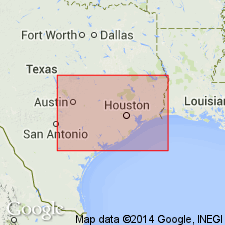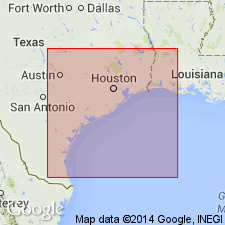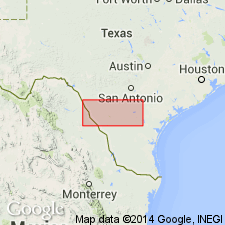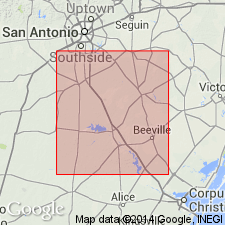
- Usage in publication:
-
- Fashing clays
- Modifications:
-
- Original reference
- Dominant lithology:
-
- Clay
- AAPG geologic province:
-
- Gulf Coast basin
Summary:
Pg. 1302, 1315, etc. Fashing clays. Fossiliferous bentonitic green clays, weathering to heavy sticky clay. Crop out from Frio River to western part of Karnes County, southeastern Texas. Thickness 110 feet in vicinity of Whitsett; absent (on surface and in wells) in western part of Karnes County. Overlies Calliham sand and underlies Olmos sand, all zones in Whitsett formation as here defined.
Typically exposed in creeks around town of Fashing, [Atascosa Co.], southeastern TX.
Source: US geologic names lexicon (USGS Bull. 896, p. 722).

- Usage in publication:
-
- Fashing clay member*
- Modifications:
-
- Revised
- Adopted
- AAPG geologic province:
-
- Gulf Coast basin
Summary:
Pg. 2624 (fig. 1), 2626 (table 1), 2633-2634. Fashing clay member of Whitsett Formation. Termed member of Whitsett. At designated type locality, thin fossiliferous sandstone, less than 1 foot thick and containing CORBULA-type pelecypods, overlies olive-gray bentonitic clay containing coquinas of CORBULA, OSTREA, and other pelecypods, and septarian calcareous concretions. This section, about 20 feet thick, is exposed on western valley wall of small branch on Hierholzer Ranch. Elsewhere banks of oyster shells are found. Overlies Calliham sandstone member; underlies Olmos sand of Ellisor (1933).
Source: US geologic names lexicon (USGS Bull. 1200, p. 1328).

- Usage in publication:
-
- Fashing Clay Member
- Modifications:
-
- Areal extent
- AAPG geologic province:
-
- Gulf Coast basin
Summary:
Fashing Clay Member of Whitsett Formation of Jackson Group. Clay with some sand beds; clay, bentonitic, laminated, pale yellowish brown to pale olive; sand beds, tuffaceous, fossiliferous with CORBICULA coquinas and banks of oysters and other pelecypods. Thickness about 100+/- feet. Lies above Calliham Sandstone Member of Whitsett. [Underlies Frio Formation (Oligocene) in most of map area except in northeasternmost part where it underlies Catahoula Formation (Miocene).] Age is Eocene.
Not separately mapped. [Present in McMullen, Live Oak, Atascosa, and Karnes Cos., southern TX.]
Source: Publication.

- Usage in publication:
-
- Fashing Clay Member*
- Modifications:
-
- Overview
- AAPG geologic province:
-
- Gulf Coast basin
Summary:
Is member of Whitsett Formation in Karnes Co, TX (Gulf Coast basin). The Calliham and Tordilla Sandstone Members of the Whitsett Formation (upper Eocene) in south Texas have been considered by Eargle (1972) to be stratigraphic equivalents. He used the term Tordilla for a fine-grained beach sandstone unit in western Karnes County and the term Calliham for medium to coarse-grained sandstone deposited in distributary channels in Atascosa and McMullen Counties to the southwest. Studies by Dickinson of new exposures provided by the uranium mining in Karnes Co show that the Calliham channels were scoured into the Tordilla beach sand, and though they are deposited physically at about the same horizon, the Calliham deposits are younger. The Calliham is equivalent in age to the Fashing Clay Member, which overlies the Tordilla in Karnes Co.
Source: GNU records (USGS DDS-6; Denver GNULEX).
For more information, please contact Nancy Stamm, Geologic Names Committee Secretary.
Asterisk (*) indicates published by U.S. Geological Survey authors.
"No current usage" (†) implies that a name has been abandoned or has fallen into disuse. Former usage and, if known, replacement name given in parentheses ( ).
Slash (/) indicates name conflicts with nomenclatural guidelines (CSN, 1933; ACSN, 1961, 1970; NACSN, 1983, 2005, 2021). May be explained within brackets ([ ]).

